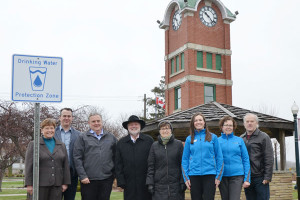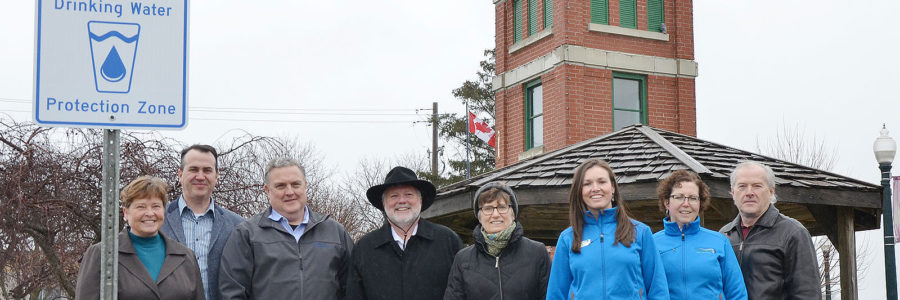North Perth is region’s first municipality to install municipal drinking water protection zone signs
Municipality of North Perth, Ausable Bayfield Maitland Valley Drinking Water Source Protection Region unveil signs to help educate people to protect sources of drinking water near municipal wells
The Municipality of North Perth is installing drinking water protection zone signs along streets near their seven municipal wells. North Perth is the first municipality in the Ausable Bayfield Maitland Valley Source Protection Region to install these signs in wellhead protection areas. Some other local municipalities plan to install signs like these in the coming months.
One of the road signs was unveiled at a ceremony in Listowel on Friday, April 1, 2016.
The Ontario Ministry of the Environment and Climate Change has supported the cost of producing and installing the signs through Source Protection Municipal Implementation Funding (SPMIF). The Province of Ontario provided this funding to support small, rural municipalities in their work to implement locally developed source protection plans that reduce risk to drinking water.
“North Perth enjoys safe and clean drinking water, however, it is important to engage people through awareness and education in order to maintain our health and prosperity by protecting our water,” said Julie Behrns, Mayor of the Municipality of North Perth. “In leading by example, North Perth is the first municipality in this region to put these protection zone signs in place,” she said. “Thanks to the Province of Ontario for providing the funding to support the cost of implementation of these signs.”
“The installation of drinking water protection zone signs is an effective way to remind residents that they are close to a municipal well and also inform visitors to our community that they are entering a protected zone,” said Mark Hackett, Manager of Environmental Services, Municipality of North Perth. “The signs are a very visible and cost-effective way to educate and remind everyone of the need to protect our water sources.”
There are nine municipalities, in the Ausable Bayfield Maitland Valley region, that have municipal wells and groundwater as their source of drinking water. The municipal drinking water protection zone signs help to remind local people and visitors to do what they can to protect these
sources.
“I applaud the Municipality of North Perth for their leadership in installing drinking water protection zone signs,” said Jenna Allain, Program Supervisor with the Ausable Bayfield Maitland Valley Drinking Water Source Protection Region. “I am also very thankful that the Ontario Ministry of the Environment and Climate Change has provided funding support to make these signs possible.” A number of other local municipalities are planning to install drinking water protection zone signs in the region this year, according to Allain. “The new signs should go a long way towards educating the public about zones of protection that reduce risk to their municipal drinking water,” she said. “Source protection is the first barrier of defence in keeping local drinking water safe and clean and the new signs strengthen that barrier of protection.”
Other potential benefits of the signs include alerting emergency responders there is a nearby well. If a spill took place this could prompt them to contact water treatment plant operators so they could shut off systems and prevent contamination.
For information on protecting drinking water sources in North Perth visit www.northperth.ca/en/municipalservices/watersewer.asp and
www.sourcewaterinfo.on.ca/maps/listowel-drinking-water-system
If you are located close to a municipal well and would like to learn if source protection plan policies apply to you, or how you can protect local drinking water sources, visit the source protection region website at sourcewaterinfo.on.ca or phone toll-free 1-888-286-2610 or email info@sourcewaterinfo.on.ca.
This website offers an interactive map, fact sheets, news feeds, risk management plan information, and practical ways you can reduce risk to local drinking water sources.
Drinking water source protection plan policies reduce risk from activities in four types of vulnerable areas:
- Wellhead protection areas (groundwater) around municipal wells
- Surface water intake protection zones
- Significant groundwater recharge areas
- Highly vulnerable aquifers
The Ontario Ministry of the Environment and Climate Change (MOECC) approved source protection plans, for the Maitland Valley and Ausable Bayfield source protection areas, on January 19, 2015. The source protection plans took effect in April of 2015.
The source protection plans include policies to address 21 activities that can pose a threat to municipal drinking water sources in certain circumstances (for example, in certain locations and in certain quantities). Examples of threat activities include septic systems and other sewage storage; liquid fuel, fuel oil, and home heating oil; some chemicals, fertilizers, pesticides; nutrients including manure; hazardous waste storage and waste disposal sites; and road salt and snow storage.
Threat activities may be assessed as low, moderate or significant threats to municipal drinking water sources. In this source protection region, significant threats to drinking water are only found in wellhead protection areas A, B, and C. The policies in those relatively small vulnerable areas reduce risk by using tools ranging from education and outreach, to risk management plans, to restricted land uses, to prohibition of some activities.
A risk management plan (RMP) is a tool that regulates activities that pose a significant threat to municipal drinking water sources. Risk management plans include best management practices designed to reduce or eliminate risks to the municipal drinking water source. These RMP plans are generally negotiated between the person doing the activity and a municipally-appointed risk management official. For example,
if fuel was stored at a service station and it was a significant threat to drinking water sources, a risk management official would work with the gas station owner to manage the threat activity. Together, they would develop a risk management plan to reduce the chance of spills from an
underground tank.
For more information visit Ontario.ca and sourcewaterinfo.on.ca.
What is a drinking water protection zone?
A drinking water protection zone may be a wellhead protection area (WHPA) around a municipal well (groundwater source from aquifers) or an intake protection zone (IPZ) around a municipal intake (a surface-water source such as Lake Huron or another lake or a river).
There are two intake protection zones in the Ausable Bayfield Maitland Valley Source Protection Region – one in Goderich;
and the second one being the Lake Huron Primary Water Supply System at Port Blake, north of Grand Bend.
There are about 25 municipal well systems (or groundwater systems) in the region, including Listowel.
When you drink water from the tap in this region it comes from aquifers underground or it comes from Lake Huron. It is important that you manage your activities at home and at work – such as storing home heating oil or other fuel; storing chemicals; or applying pesticides, fertilizers, or manure. It is important you maintain your septic system, your home heating oil storage, and your well (or properly decommission an unused well). It is important to find safer products, store less, and store better; and be careful what products you apply, how much, and where. It is especially important to do these things near your municipal well or intake. By improving your storage practices; by maintaining your fuel storage,
septic systems, and wells; by avoiding application of nutrients or pesticides of fertilizers near wells; and by completing risk management plans and spills prevention plans – you can help to keep your local drinking water safe and clean.

The Municipality of North Perth is the first municipality in the Ausable Bayfield Maitland Valley (ABMV) Drinking Water Source Protection (DWSP) Region to start installing drinking water protection zone signs. Unveiling a new sign in Listowel on Friday, April 1, 2016 were (from left to right), Julie Behrns, Mayor of the Municipality of North Perth; Kriss Snell, Chief Administrative Officer, North Perth; Mark Hackett, Manager of Environmental Services, North Perth; Matt Pearson, Acting Chairman, Ausable Bayfield Maitland Valley Source Protection Committee (SPC); Karen Galbraith, SPC member; Jenna Allain, Program Supervisor for ABMV DWSP; Mary Lynn MacDonald, Risk Management Official; Mark McKenzie, SPC member. The new signs help to educate residents and visitors that they are near a municipal well and should do everything they can, at home and work and while travelling through the municipality, to protect the municipal drinking water source to keep the water supply safe and clean. Several other municipalities are expected to install road signs later this year.
For more information visit Ontario.ca and sourcewaterinfo.on.ca.




